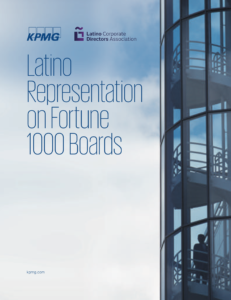
Despite growing shareholder interest in corporate diversity, there remains a substantial shortage of Latino/a representation on F1000 boards. LCDA’s research showcases significant gaps in states with sizable Latino populations (Texas, Florida, and California) and across industries such as technology, materials, and aerospace and defense.
The importance of the Latino community to the U.S. economy cannot be overstated. Latinos comprise just over 18% of the US population1 and this percentage is expected to grow to 29% by the year 2050.2 The contributions to the U.S. economy made by Latinos is significant and is also expected to grow dramatically in coming decades. Consider these facts: —Latinos3 accounted for 82% of the growth in the U.S. labor-force participation between 2010 and 20174 —GDP among Latinos has grown at a faster rate than the overall U.S. economy, growing from $1.7 billion in 2010 to $2.3 billion in 20175 —The purchasing power of the Latino community is expected to top $1.9 trillion by 2023.6 As business leaders plan for long-term growth and sustainability, they must take into consideration the role that Latinos will play as their companies’ employees, consumers and business partners. However, the Latino voice is rarely represented in the corporate boardroom, despite increasingly loud calls for improved diversity on boards. For a variety of reasons, discussions about board diversity have predominantly focused on gender. However, racial and ethnic background is an important aspect of board diversity as well. To date, studies of the racial and ethnic backgrounds of directors have been limited by a lack of consistent data since boards are not required to disclose the demographics of each director in their regulatory filings. Based on data that has been collected and verified by the Latino Corporate Directors Association, this study provides a unique perspective on the state of Latino representation in the boardrooms of U.S. corporations as of July 31, 2019.
To view the PDF, click here.



